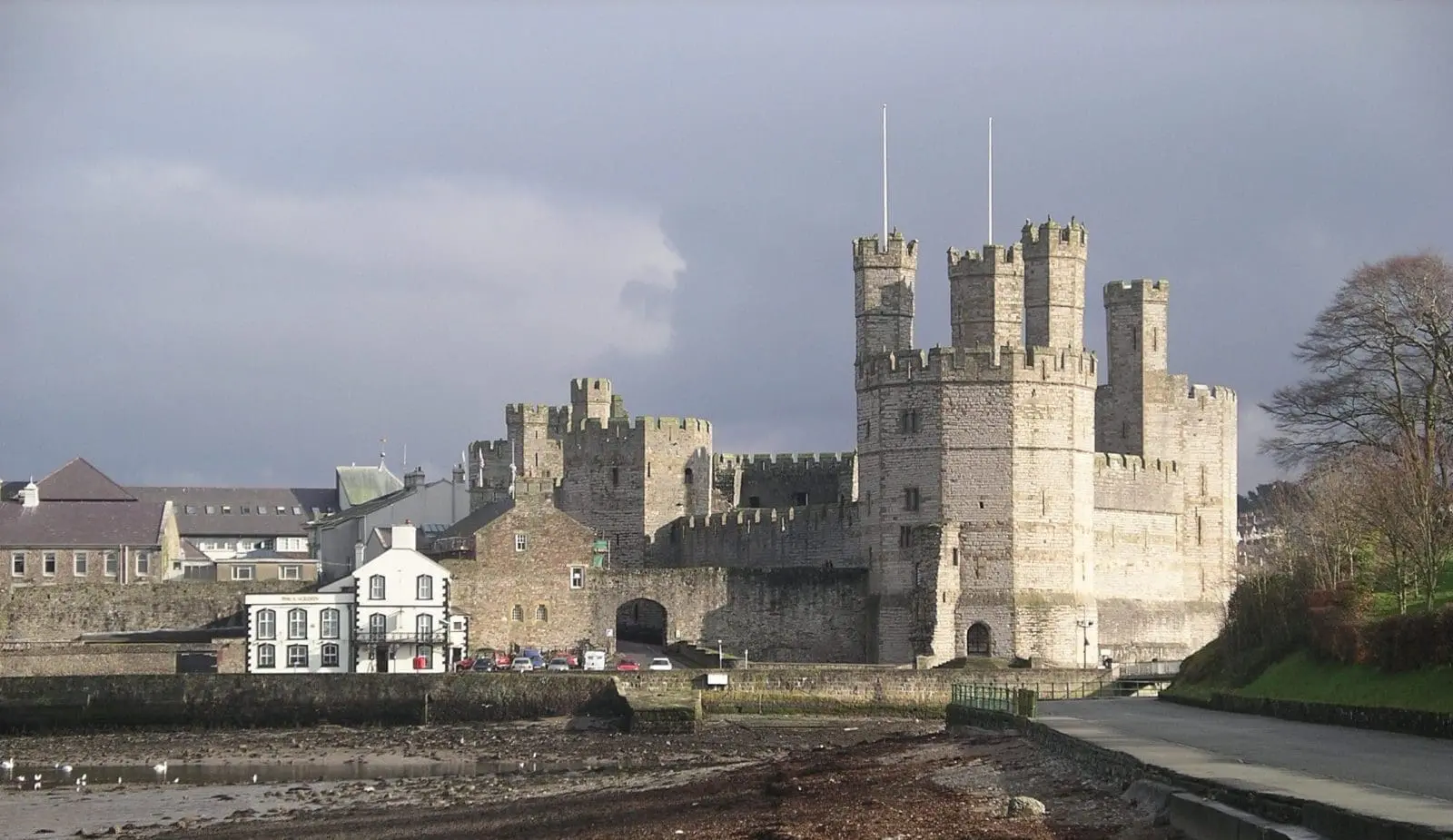Your basket is currently empty!

Caernarfon Castle: Why it Was Built
Constructed between 1283 and 1330 during King Edward I of England’s conquest of Wales, this formidable edifice provokes an important historical question – why was Caernarfon Castle built? The massive castle served several key strategic roles in helping England subjugate the Welsh nation.
Caernarfon stood as a military strongpoint, administrative headquarters, center of royal ceremony and spectacle, and towering symbol of English authority. Examining the motivations behind erecting this intimidating castle provides insight into Edward I’s aims in Wales and the shifting balance of power during Britain’s medieval period.
Why Was Caernarfon Castle Built?
Caernarfon’s location was strategically chosen by King Edward to facilitate English governance of the troublesome region of Gwynedd in Northwest Wales. This region had long been home to numerous Welsh princes and the heartland of Welsh cultural identity. Constructing such an awe-inspiring castle in the former royal abode of the Welsh rulers sent a clear message – that English authority was here to stay.
Hear from King Edward why Caernafon Castle was built
Strategic Military Role
A Stronghold Against Rebellion
The location and formidable defences of Caernarfon Castle allowed it to serve as a crucial bastion of English military might in North Wales. Situated just offshore from the Menai Strait, it commanded an important river crossing site and controlled access between the mainland and Anglesey. Any Welsh forces wishing to move between these areas could thus be monitored and interdicted.
Choking Off Welsh Resistance
Garrisons stationed at Caernarfon were able to carry out regular mounted patrols through surrounding towns and villages, projecting English authority and quashing any stirrings of rebellion amongst the local populace. With Caernarfon as an impenetrable base, English soldiers could swoop through the countryside, stamping out resistance before it could gain momentum.
Depriving the Enemy
As a powerful forward base, the castle allowed English armies campaigning deeper into Welsh territory to be resupplied via river vessels. Meanwhile, by raiding livestock and burning crops in the area, Caernarfon’s garrison could deprive Welsh forces of vital resources, contributing to their defeat in the field. The fortress thus formed a key part of the English strategy to subjugate Wales through both military might and attrition.

Administrative Headquarters
Imposing English Law

Beyond its military utility, Caernarfon Castle served as an imposing seat of English administrative authority in North Wales. Within the castle walls, royal officials enforced English laws and policies upon the surrounding region. This allowed King Edward to consolidate his control and anglicize the turbulent Welsh territories.
Dispensing Justice
Caernarfon contained royal courts where English judges, appointed by the King, dispensed justice according to English custom. Welsh nobles who wished to retain their privileges had little choice but to appeal before these foreign courts that were alien and hostile to native Welsh law. This was a key means of imposing external authority.
Overseeing Royal Authority
The castle also housed English sheriffs, tax collectors, and other officials integral to implementing the crown’s writ in Wales. Together with the courts, this administrative apparatus allowed England to govern North Wales directly, diminishing the authority of local Welsh rulers. Caernarfon became a seat of colonial power – not just a military site.

Royal Ceremonial Site
Rituals of Submission
As a powerful symbol of English dominance in Wales, Caernarfon Castle became the stage for rituals requiring Welsh rulers to submit to King Edward’s sovereignty. Within the ornate halls of the castle, the English king would receive visiting Welsh nobles and princes, who would kneel and swear oaths of fealty to him.
Pomp and Circumstance
Lavish feasts and tournaments attended by English and Welsh nobility were hosted at Caernarfon. On such ceremonious occasions, King Edward would sit elevated above the participants, demonstrating his might and prestige to impressionable Welsh elites bedazzled by English finery and chivalry. This cultivated their acquiescence to English rule.
Investing the Heir

In 1301, Edward’s son and heir, the future Edward II, was born at Caernarfon and proclaimed the Prince of Wales. This established the castle as the traditional site for investing the king’s eldest son as Prince, further cementing its role as a center for royal pageantry and Welsh submission to English sovereignty.
Symbol of English Power
Architecture of Oppression
The sheer scale and sophisticated design of Caernarfon Castle were intended to awe and intimidate the Welsh population. The enormous polygonal towers, intimidating battlements, soaring Eagle Tower gatehouse and geometric multi-colored stonework conveyed the military might and artistic refinement of England. This contrasted starkly with the crude earthworks and stone fortresses of the native Welsh rulers.
Flaunting Superiority
While much of Wales languished in backwardness and poverty, the splendor and treasure lavished on Caernarfon projected English wealth and invincibility. As the preeminent castle in Wales, Caernarfon stood as a permanent monument to the permanence and cultural supremacy of English rule. Generations of Welsh natives would gaze upon its grandeur knowing that England would dominate their land indefinitely.
Built on the Backs of the Welsh
Adding further humiliation, much of the punishing labor required to construct Caernarfon was carried out by impressed Welsh work teams. Conscripting the Welsh to physically build the instruments of their own oppression under brutal working conditions was a calculated move by King Edward to break their spirit of independence.
The Enduring Legacy
A Controversial Landmark
For centuries after its completion, Caernarfon Castle stood firm as a landmark commemorating English conquest of Wales. While the castle remains an impressive architectural achievement, its symbolism as an icon of subjugation still touches a raw nerve for many modern Welsh.
Related Articles
How to find Caernarfon Castle
Map to Caernarfon Castle Map and directions
Caernarfon Castle address Castell Caernarfon, Allt y Castell, Caernarfon, Gwynedd, Wales, LL55 2PG, United Kingdom
Places to stay
Discover more from Histories and Castles
Subscribe to get the latest posts sent to your email.












